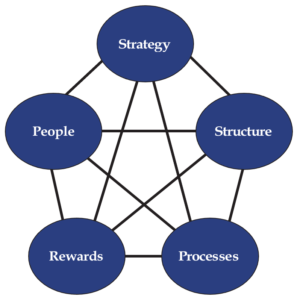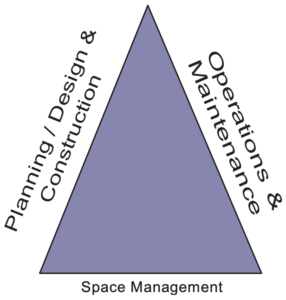The chief facilities officer is responsible for the design of the facilities management organization, which faces new challenges (e.g., customer service, economics, workforce, information technology). Managers must redesign organization structures, strategy, and purpose as service requirements and environments change.
Organization theory and design practices are evolving, supported by the APPA knowledge base.
Effective Organizational Design
Differences Matter. When considering changes in organization structure, facilities managers first look at organization charts for other facilities departments.
Although useful, this approach must be supplemented by research to identify organization-specific traits and the rationales for organizational design choices.
Strategy Before Structure. Organizational design is an important determinant of organizational success.
Organizations tend to function most effectively when design is shaped to meet needs posed by work to be done. Facilities management structures evolve over
time in fits and starts, a dynamic environment that requires both deliberate alignment of organizational design and periodic structural revision. Design analysis begins with the distinct facilities management department mission and strategy, but only after defining “organization”— a social unit of (empowered) people and relationships structured, coordinated, and managed to meet a need or pursue goals—and understanding the evolution of organizational design.
Brief History of Organizational Theory and Design. Organizational scholars search for patterns and define, measure, and make them available. The concept of creating a system for maximum efficiency and organizing work for maximum productivity (a product of the Industrial Revolution) is associated with development of hierarchy and bureaucracy and is still embedded in management theory, practice, and structures. Another theory posed 14 management principles (the foundation of modern practices) emphasizing rational design and management (e.g., clearly defined authority and responsibilities, formal recordkeeping, uniform application of standard rules). The Star Model is a continual decision process to bring coherence among people, organizing form, and strategy. It is (composed of strategy, structure, people, processes, and rewards and their associated variables) supported by organizational resources available to implement the strategy (see Figure 1.3).

Figure 1.3. The Star Model
Larger Organizational View. The facilities management department can be large, but it is just part of the higher education enterprise that the university serves and only one of many academic and nonacademic administrative campus organizations. Although no size fits all, institutional organizational design tends to be similar based on descriptive variables such as the Carnegie classification of an institution
Institutional Environment. Many organizational problems can be avoided if facilities managers plan the structure to meet (and align the organizational design with) business objectives (mission, vision, strategy, goals). Managers need to describe the organizational setting (internal structural and external contextual dimensions), using an environmental scan—a Strengths, Weaknesses, Opportunities, and Threats (SWOT) analysis—and its companion Social, Technological, Economical, Environmental, and Political (STEEP) tool.
The manager then can think comprehensively about organizational design and structure.
Core Competencies of Organization. SWOT analysis includes assessment of core competencies (deep proficiencies for the delivery of unique value to customers) and core capabilities (system of reinforcing activities that bring strategic choices to life). In the APPA organizing framework, facilities management core competencies are concentrated in four functional areas (general administration and management; operations and maintenance; energy, utilities, and environmental stewardship; and planning, design, and construction).
Each functional area is broken down into facilities services functions, activities, or divisions, allowing strategic grouping of tasks and activities and enabling better management of investments in capabilities.
Organizational Capabilities, Activities, and Core Competencies
Many facilities management departments strive for greater horizontal coordination of work activities.
Organizational design entails (1) strategic grouping of resources for economies of scale, specialization, and integration and (2) strategic linking of structural mechanisms to coordinate interdependent areas.
Strategic Grouping and the APPA Framework as an Organizational Design Tool. The APPA Core Competence Framework illustrates strategic grouping practices for facilities management organizations by size (small, medium, large)—a correlate of complexity—for each of the four functional areas. Most management books and business schools study corporations, but facilities management groups are very small; the largest have fewer than 1,600 staff members, and most have fewer than 500 personnel. This chapter summarizes the characteristics of small, medium, and large groups in each functional area. In a properly designed organization, the choices of services and how to provide them (including quality, cost, management processes, support, and performance metrics) account for differences in organizational structures and are determined by both the facilities manager and the institution’s priorities and available resources.
Boundaries and Scope. Organizations use boundaries to group people, processes, and activities based on functions and logical division of labor. As former APPA President Bill Middleton noted, the triad of facilities management functions (planning, design, and construction; operations and maintenance; and management of space assignment and use) are loosely decentralized in most institutions, but a more comprehensive approach and closer organizational relationship are warranted (e.g., to exchange relevant information and improve resource allocation). This triad paradigm (see Figure 1.4) was most popular in the latter part of the 20th century, but only a small percentage of facilities management departments have succeeded in adopting this model.

Figure 1.4. The Triad Organization
New Organizational View: What’s Ahead for 21st Century Facilities Management Organizations?
Dealing with a constant flow of change requirements arising from institutional advancements and specific campus environments over five decades, facilities managers have used controlled and evolutionary action; where only a few major changes required a rapid response. Most institutions have similar strategic orientations but might not be in sync with the dramatic
changes of the 21st century. Research shows that hierarchies have flattened, but no facilities management group has designed an innovative management model that differs significantly from the hierarchical model.
Retooling of the legacy management and organizational model (e.g., technology, process improvements, zone maintenance) is viable compared to major reorganization.
New Success Factors. Old success factors (e.g., size, role definition, specialization, control) are being augmented or replaced by new ones (speed, flexibility, integration, innovation, nurturing of relationships), but facilities managers always face vertical, horizontal, external, and geographic boundary constraints.
Knowledge Worker. The advent of information technology (especially in communications) and professionals with specialized expertise (knowledge workers) who represent a larger and growing percentage of the facilities management workforce have had a major impact in the last decade on management (inverting the pyramid), organizational design, and practices.
Learning Organization. Continuous improvement involves a commitment to learning. Continual learning for improvement supports the use of best practices and is an essential ingredient and perhaps ultimate goal of the learning organization. However, the learning organization has more to do with activities than structure, although organizational structure can encourage or inhibit the learning and knowledge sharing that better equip the staff to handle increasing complexity and continual change. Based on 50 evaluation program reports between 1990 and 2012, a summary of successful facilities management organizational practices concluded that the design of facilities management organizations is a significant determinant of organizational success (see Figure 1.5).
Figure 1.5. The Five Disciplines
| The Five Disciplines | Leadership Competencies | Followership Expectations |
| Personal Mastery | Compassion
Self and other acceptance Shared power Authenticity Nurturance of spirit Moral leadership Sensibility Humility Mastery Growth oriented Risk taking Self-directed Tolerance Value ambiguity Learning commitment Trust Spirituality Ego subordination |
Encouragement Acceptance Empowerment Trust
Self-discovery Someone worth working for Dignity Autonomy Fulfilled potential Growth Supported choice Independence Space to make mistakes Support in transition Learning Responsibility Self/other connection Ownership of results |
| Mental Models | Insight Introspection
Challenge assumptions |
Innovation Meaning
Challenge assumptions |
| Shared Vision | Principles
Personal/co. values alignment Inspiration Goals Vision Vitality Mobilize commitment |
Sense of purpose Personal/company values alignment Motivation
Clarity Codevelopment vision Engagement Commitment |
| Team Learning | Cooperation Dialogue Listening Creativity Promote harmony
Encourage relationship |
Codesign
Self-expression Contribution Creativity Social unity Relationship |
| Systems Thinking | Expansionist thinking Understanding of connectivity Intuition
Perspective Integration |
Understanding the whole |
Source: The Fifth Discipline, by Peter M. Senge
 Create an Account
Create an Account
 Login/myAPPA
Login/myAPPA
 Bookstore
Bookstore
 Search
Search  Translate
Translate 
Leave a Reply
You must be logged in to post a comment.